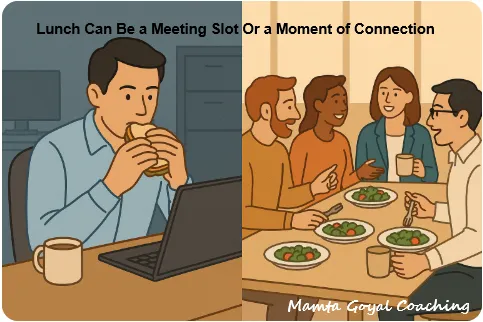
Lunch Breaks Are Disappearing for Knowledge Workers: Why It Matters More Than You Think
Lunch Breaks Are Disappearing For Knowledge Workers: Why It Matters More Than You Think
The Problem: Lunch Is Quietly Vanishing
Return-to-office (RTO) mandates were sold as the solution to cultural drift—get people back together, spark spontaneous conversations, and build collaboration. But there’s a hidden snag: lunch, the most natural moment for human connection at work, is disappearing.
A 2024 ezCater Lunch Report found that 62% of employees don’t leave their desks for lunch, and nearly half skip a lunch break at least once a week. [Korn Ferry, 2025] echoed the trend: the noontime meal, once a communal anchor, is now just another slot filled with emails, Slack messages, or meetings.
Microsoft’s Work Trend Index (2023) adds more context: workers are interrupted every 2 minutes on average by pings, calls, or meetings. In such an environment, breaks feel like a luxury.
Even office cafeterias and nearby restaurants—once central to office culture—report quieter mid-day traffic. [HR Dive, 2024]
If RTO was supposed to bring us together, then skipping lunch tells us something important: presence alone isn’t producing connection.
Why Lunch Matters Beyond Food
Lunch is more than fuel. It is:
A restorative break → stepping away reduces stress and cognitive fatigue.
An informal collaboration hub → ideas exchanged at the lunch table often solve what formal meetings can’t.
A cultural glue → breaking bread together builds trust and strengthens relationships.
Research from organizational behavior experts shows that social capital—the network of trust and goodwill—forms in these informal moments. Losing them has costs that no “extra meeting” can replicate.
What’s Replacing Lunch?
From employee self-reports and observational studies, here’s how lunch is being reallocated:
Eating at the desk while emailing.
Attending back-to-back meetings.
Quick snacks between tasks.
Virtual catch-ups or mandatory calls that overlap lunch hours.
Occasional solo activities like walking, but these remain in the minority.
What’s missing? Shared experiences. Lunch is shifting from communal to isolated, from downtime to uptime.
Why This Shift Is Happening
Productivity pressure: Many feel judged if they “step away,” equating lunch with lost time.
Meeting overload: The open 12–1 block is the easiest slot to fill, so it often becomes another meeting window.
Hybrid fragmentation: On-site days don’t always overlap across teammates, so the cafeteria feels half-empty.
Cultural cues: If leaders eat at their desks, employees follow suit.
Spaces that discourage gathering: Sterile or inconvenient lunch areas push people back to their desks.
Are RTO Goals Being Achieved?
Evidence suggests: not really.
A Nature study (Bloom et al., 2023) found hybrid work had no negative effect on performance and reduced quit rates by ~1/3.
WFH Research shows that flexibility, not location, predicts morale and retention.
An SSRN study (Ding & Ma, 2024) links RTO mandates to lower employee satisfaction without clear gains in financial performance.
If RTO was meant to boost collaboration and culture, missing lunch underscores a hard truth: proximity ≠ connection.

A Personal Reflection
I remember early in my career, our cafeteria was where the best learning happened. A senior engineer once sketched out an entire architecture idea on a napkin while we shared lunch. That five-minute conversation solved a problem the formal design review missed.
Fast-forward to today: if everyone is eating alone at their desks, those napkin insights never surface. We lose not only camaraderie but also creativity.
Framework for Leaders: RTO Beyond Presence
Think of RTO through the 3C Lens:
Collaboration → Are we actually fostering conversations across boundaries?
Culture → Do employees feel belonging, or is presence just monitored attendance?
Care → Do policies protect well-being, including something as simple as a meal break?
If lunch disappears, all three are at risk.
Conclusion
Lunch isn’t about food. It’s about connection, culture, and care.
RTO without intentional design risks becoming “return to desk.” Protecting and reimagining lunch might be one of the simplest, most human ways to achieve the original goals of collaboration, creativity, and culture.
👉 Question for readers: How does your team approach lunch today?
